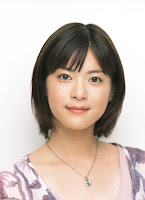|
|
|---|
Tuesday, September 29, 2009


Thanks for support, for more detail and photos about Na-yeong Lee. Please visit our new website. Please click here: http://asianhotbeauty.com
Labels: (KO)Na-yeong Lee 李娜英
Monday, September 28, 2009
 Pokemon, whether it be TV cartoons, movies, trading cards or one of the more than 1,000 associated products, has generated billions of dollars for its parent company, Nintendo, since its launch as a video game in early 1996. And the phenomenon is not confined to Japan. Led by the hero Satoshi and point man (monster) Pikachu, it swept across the world in just three years.
Pokemon, whether it be TV cartoons, movies, trading cards or one of the more than 1,000 associated products, has generated billions of dollars for its parent company, Nintendo, since its launch as a video game in early 1996. And the phenomenon is not confined to Japan. Led by the hero Satoshi and point man (monster) Pikachu, it swept across the world in just three years. Labels: Saaya Irie
 Introduced to the US as a TV cartoon in September 1998, Pokemon generated an estimated 700 million dollars in retail sales in the following year. The weekly cartoon became the top-rated kid's TV show and the video 'Pokemon: Seaside Pikachu' topped the bestsellers list. Sociologists engage in serious debate about the educational value of kids' obsession with Pokemon cards. The logistics, tactics and pure arithmetic involved in pitting the various monsters, each with their own strengths and weaknesses, against each other certainly make kids use their brains. And the fact that the monsters don't die as a result of their battles - they just faint - is a welcome change from the usual cartoon carnage. But stories of schoolyard fights over cards and the kind of money changing hands - some cards are traded at over 100 dollars apiece - also cause concern.
Introduced to the US as a TV cartoon in September 1998, Pokemon generated an estimated 700 million dollars in retail sales in the following year. The weekly cartoon became the top-rated kid's TV show and the video 'Pokemon: Seaside Pikachu' topped the bestsellers list. Sociologists engage in serious debate about the educational value of kids' obsession with Pokemon cards. The logistics, tactics and pure arithmetic involved in pitting the various monsters, each with their own strengths and weaknesses, against each other certainly make kids use their brains. And the fact that the monsters don't die as a result of their battles - they just faint - is a welcome change from the usual cartoon carnage. But stories of schoolyard fights over cards and the kind of money changing hands - some cards are traded at over 100 dollars apiece - also cause concern. Labels: Saaya Irie
Friday, September 25, 2009
 Although the first home-grown movies appeared before the end of the last century, it wasn't until after World War I that they became something more than adaptations of stage plays and kabuki. The Nikkatsu and Shochiku film companies started at this time. From about 1920, Japanese film was divided into two main categories: Jidai-geki, or period films and Gendai-geki, or films with modern settings. The jidai-geki usually centered around a lone swordsman, who struggled to reconcile the conflict between his obligations (giri), and his true feelings (ninjo). This theme later became central to the gangster, or yakuza genre, originated by the Toei comapny in the 1960's. Gendai-geki reflected social changes of the day and individual director's views on life and society.
Although the first home-grown movies appeared before the end of the last century, it wasn't until after World War I that they became something more than adaptations of stage plays and kabuki. The Nikkatsu and Shochiku film companies started at this time. From about 1920, Japanese film was divided into two main categories: Jidai-geki, or period films and Gendai-geki, or films with modern settings. The jidai-geki usually centered around a lone swordsman, who struggled to reconcile the conflict between his obligations (giri), and his true feelings (ninjo). This theme later became central to the gangster, or yakuza genre, originated by the Toei comapny in the 1960's. Gendai-geki reflected social changes of the day and individual director's views on life and society.Labels: Ai Shinozaki
 Censorship by the increasingly militaristic government continued through the 1930's and World War II, although its guidelines were largely ignored. The US occupation temporarily banned pre-1945 films and clamped down on the sword-wielding jidai-geki. But after control of the movie industry was handed over to the independent Motion Picture Code Committee in 1949, they soon came back in force.
Censorship by the increasingly militaristic government continued through the 1930's and World War II, although its guidelines were largely ignored. The US occupation temporarily banned pre-1945 films and clamped down on the sword-wielding jidai-geki. But after control of the movie industry was handed over to the independent Motion Picture Code Committee in 1949, they soon came back in force.
Labels: Ai Shinozaki
Wednesday, September 23, 2009


Thanks for support, for more detail and photos about Ueno Juri. Please visit our new website. Please click here: http://asianhotbeauty.com
Labels: (JP)Ueno Juri
Thursday, September 17, 2009


Thanks for support, for more detail and photos about Siti Norhaliza. Please visit our new website. Please click here: http://asianhotbeauty.com
Labels: (MY)Siti Norhaliza
Tuesday, September 15, 2009


Thanks for support, for more detail and photos about Joyce Zhao Hong Qiao. Please visit our new website. Please click here: http://asianhotbeauty.com
Labels: (TW)Joyce Zhao Hong Qiao 趙虹喬
Thursday, September 3, 2009


Thanks for support, for more detail and photos about Sakai Noriko. Please visit our new website. Please click here: http://asianhotbeauty.com
Labels: (JP)Sakai Noriko
Wednesday, September 2, 2009


Thanks for support, for more detail and photos about Jang SeoHee. Please visit our new website. Please click here: http://asianhotbeauty.com
Labels: (KO)Jang SeoHee

































